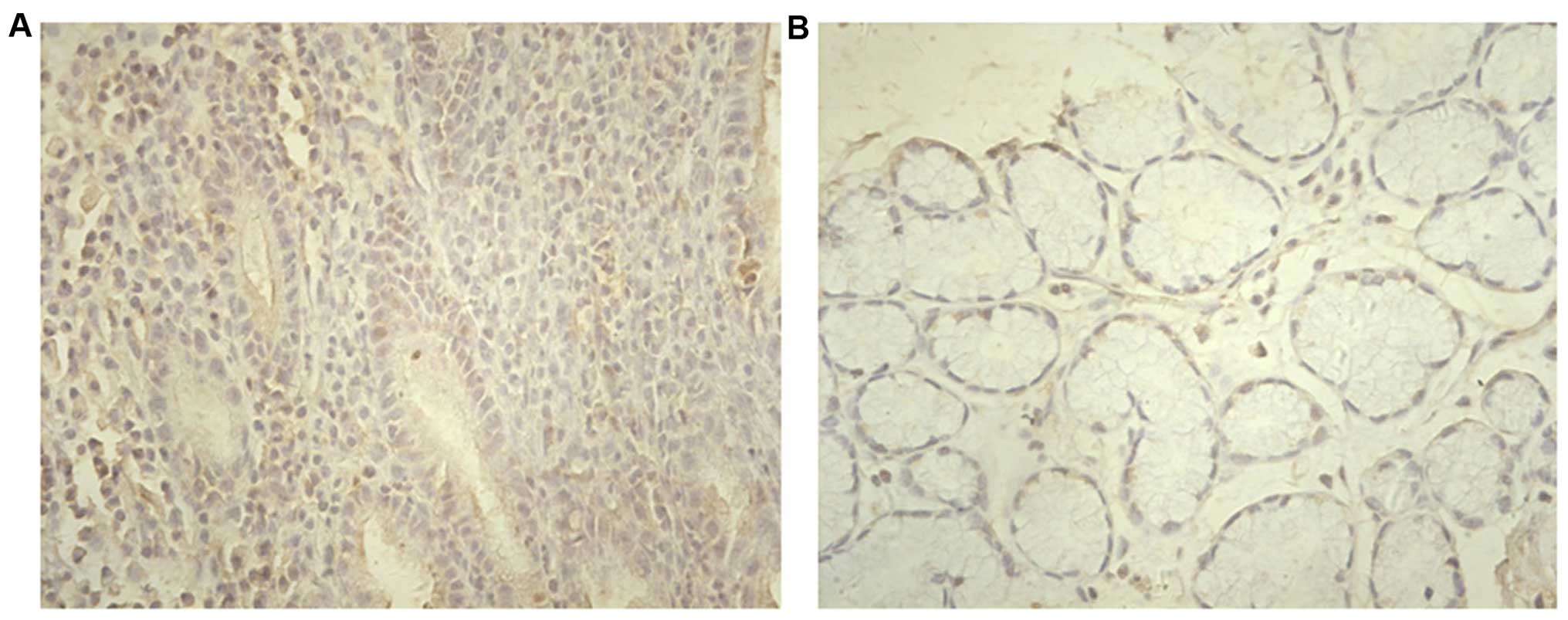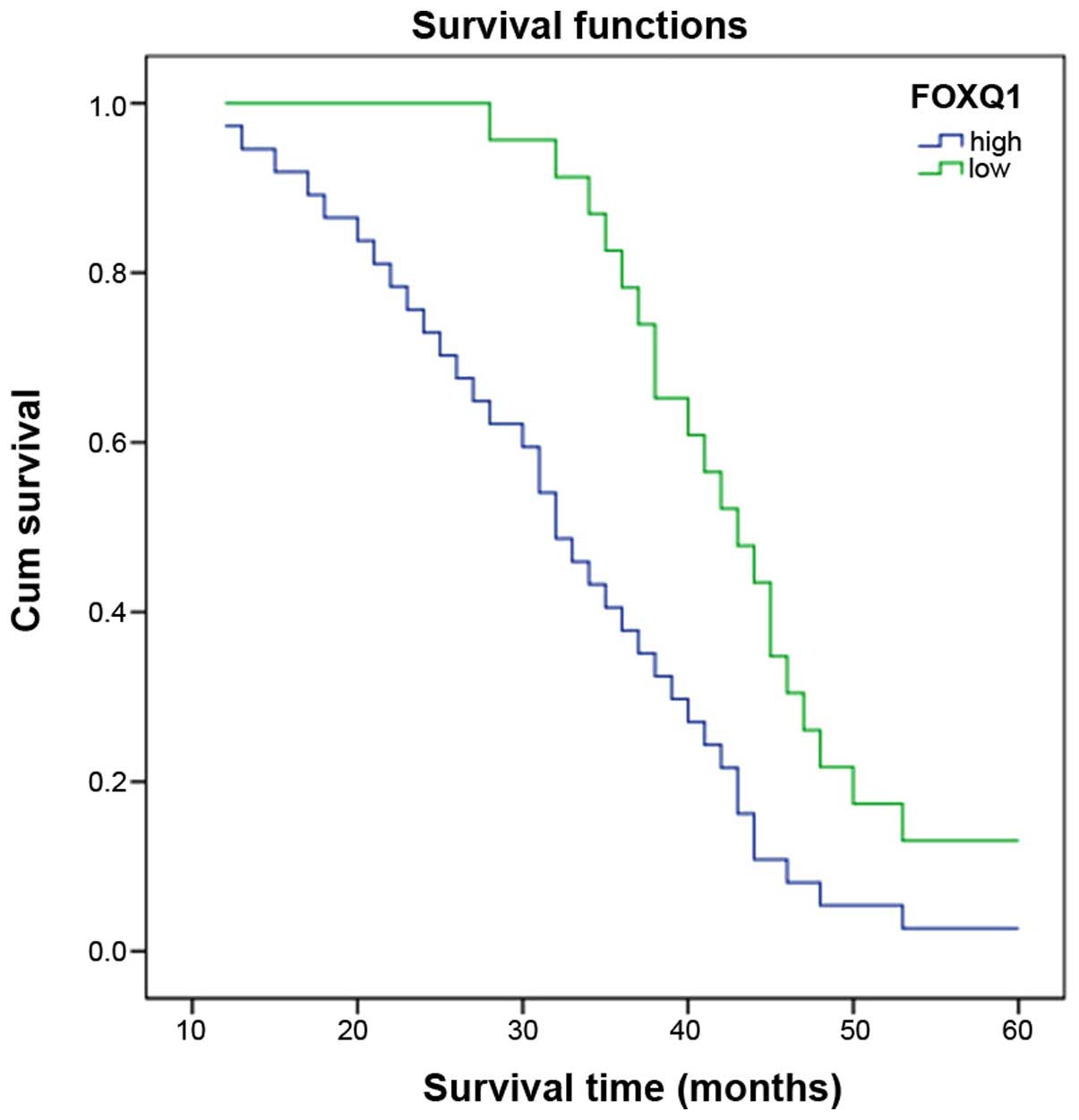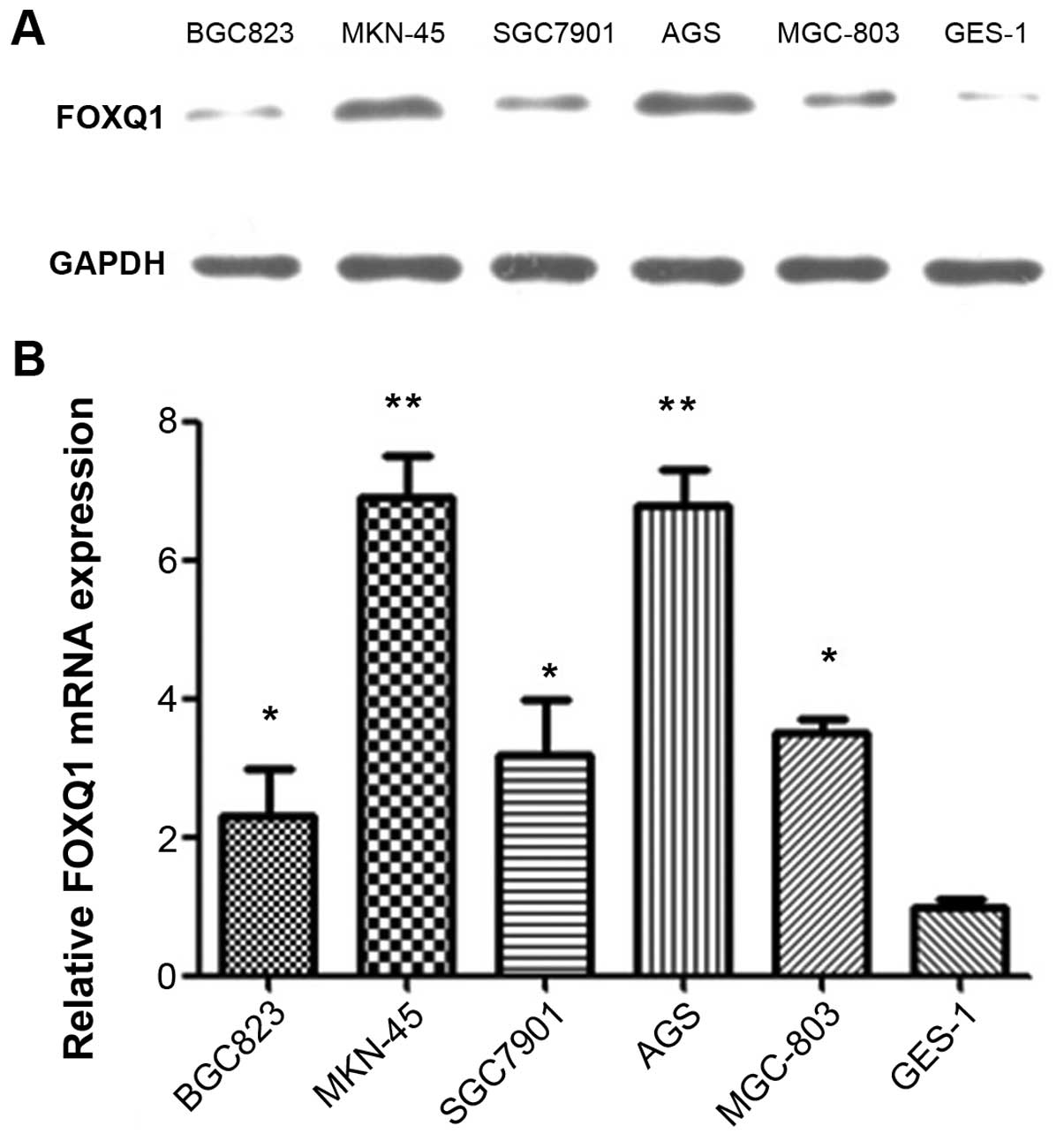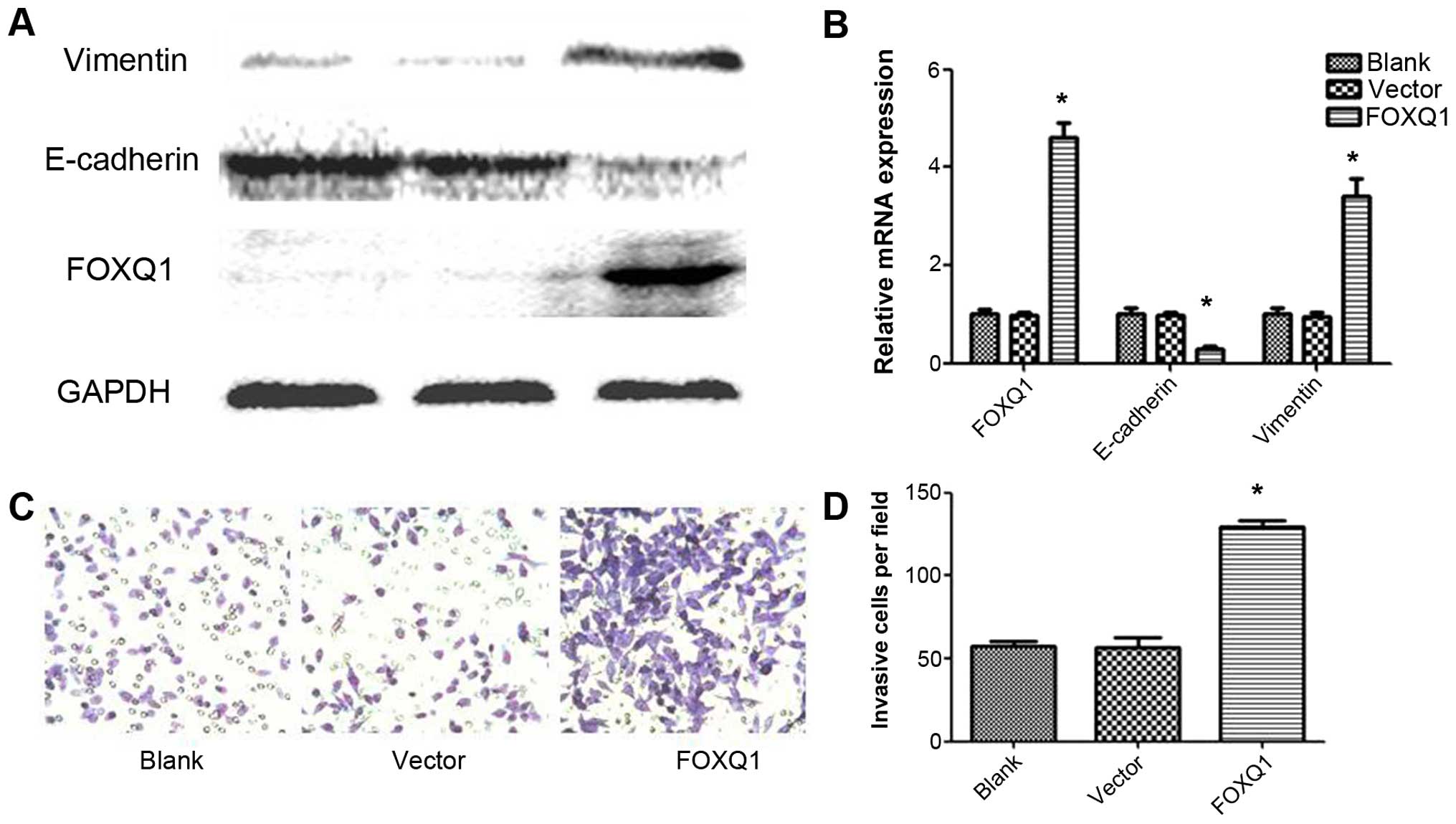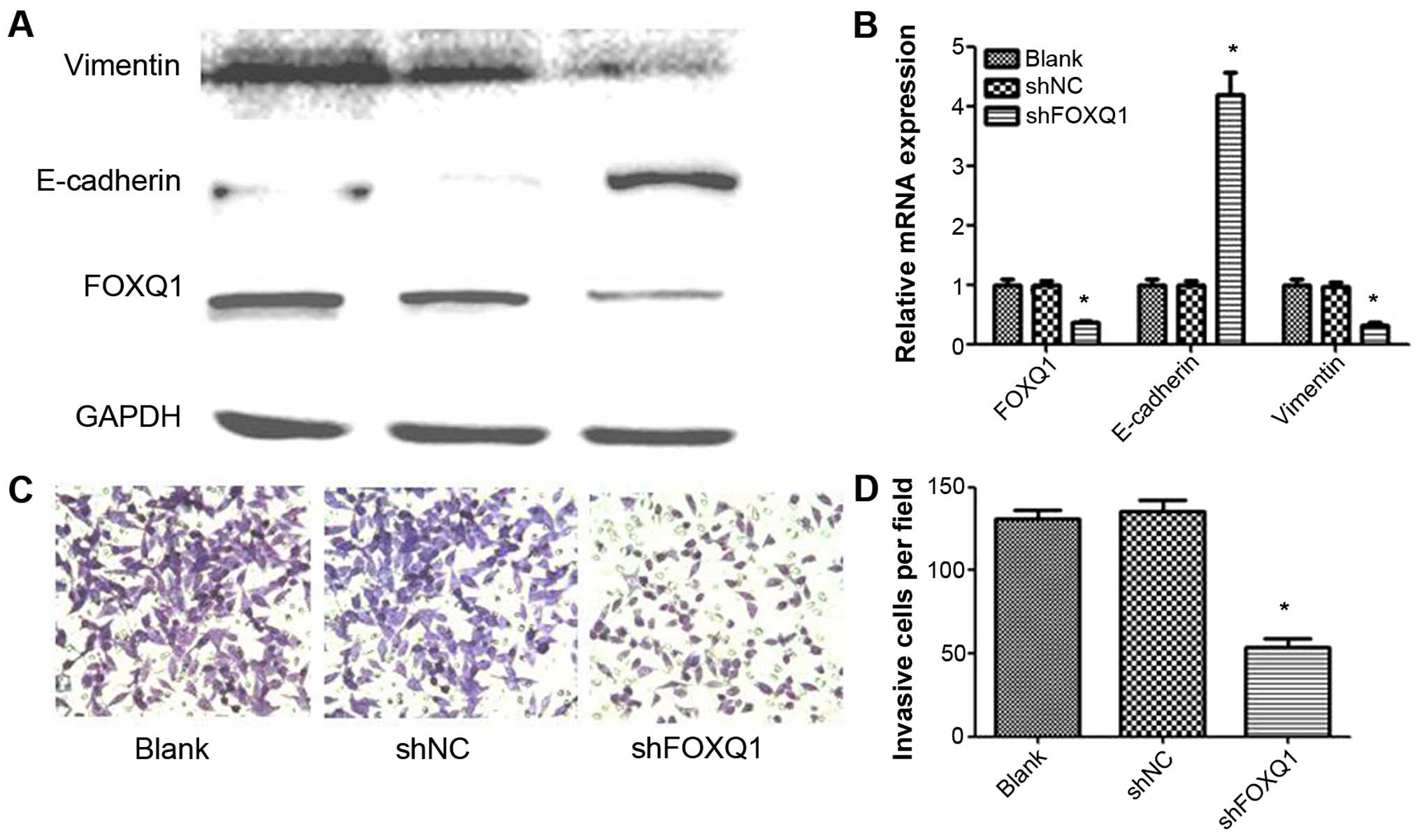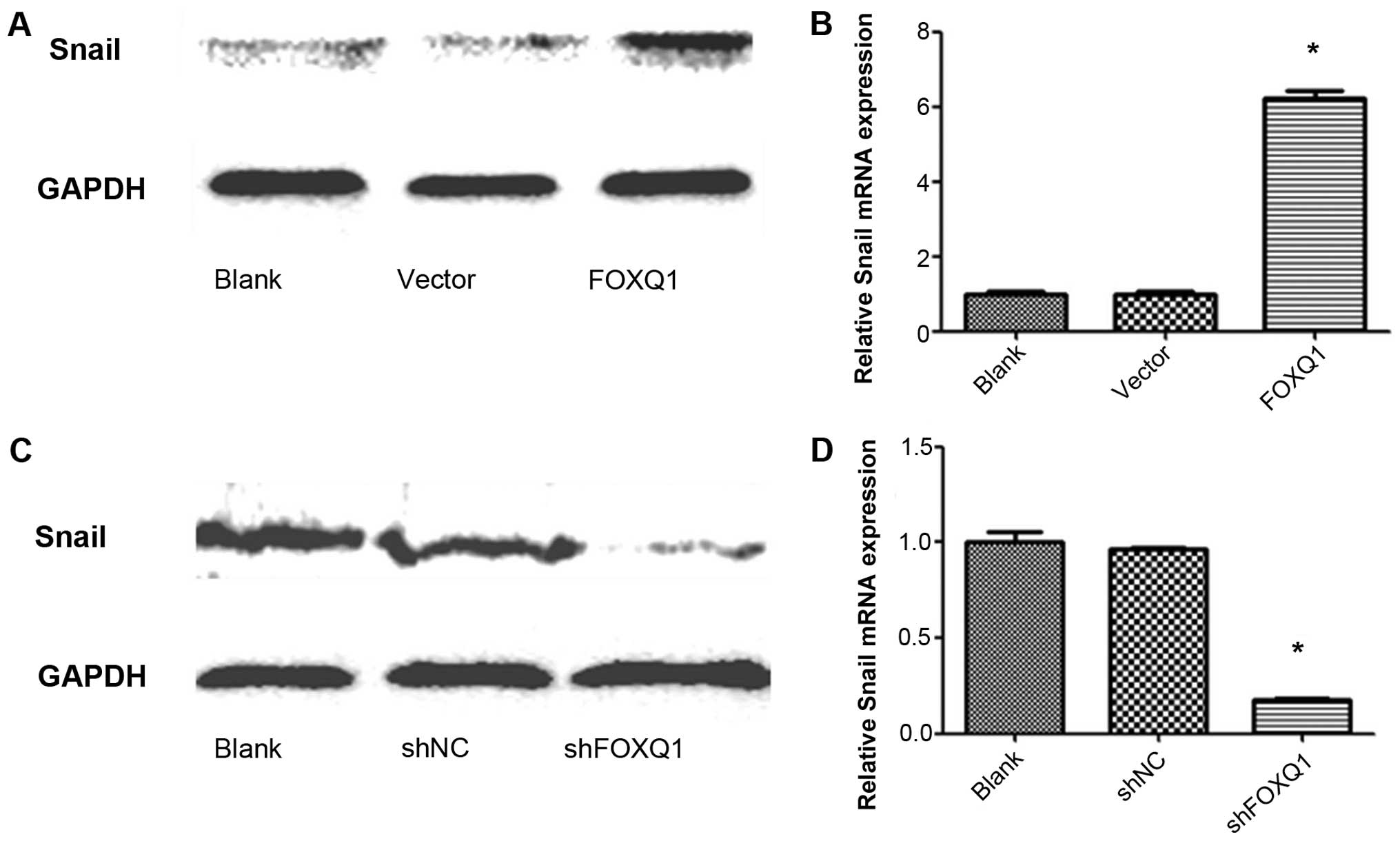Introduction
Gastric cancer (GC) is one of the most common
cancers, and the second most common cause of cancer deaths
worldwide (1). Despite improvements
in diagnostic and treatment strategies, the prognosis for advanced
stage GC patients is still very poor (2). This is mainly because of the high
incidence of metastasis and recurrence in GC patient (3). Therefore, a better understanding of
the molecular mechanisms involved in the progression of GC is
important for the development of novel therapeutic strategies for
the treatment of patients with GC.
In 1968, Elizabeth Hey first defined the concept of
epithelial-mesenchymal transition (EMT). It is an essential
embryonic process during which epithelial cells loose contact with
their neighbors and gain mesenchymal properties, this could enable
them to break through the basement membrane which separates
different tissues from the embryo (4). In the last few years, an increasing
number of studies reported that aberrant reactivation of EMT could
promote tumor cell migration and invasion by disruption of
apical-basal polarity and loss of E-cadherin expression (5,6).
Increasing evidence have revealed that many growth factors,
cytokines and cellular signaling pathways play important roles in
initiation and execution of EMT, including TGF-β, FoxM1, HGF, EGF,
NFκB, Notch, Snail, ZEB1, ZEB2, Twist1, KLF4, KLF8, Sox9 and Wnt
(5,7–10).
Thus, it is essential to clarify the possible signaling pathways in
EMT of GC.
Forkhead box Q1 (FOXQ1, also known as HFH1) is a new
member of the forkhead (FOX) transcription factor family. It
contains the core DNA binding domain, whereas the flanking wings of
FOXQ1 contribute to its sequence specificity (11). FOXQ1 has been shown to repress the
promoter activity of smooth muscle-specific genes such as SM22α and
telokin in A10 cells (12). A
previous study reported that FOXQ1 plays critical roles in hair
follicle morphogenesis and gastric epithelial differentiation
(13). Increasing evidence
indicates FOXQ1 overexpression in different human cancers,
including colorectal cancer, esophageal cancer, hepatocellular
carcinoma, breast cancer, and non-small cell lung cancer, and its
upregulation enhances tumor growth and invasion (14–23).
FOXQ1 has been shown to regulate EMT and function in breast cancer,
non-small cell lung cancer, colorectal cancer and hepatocellular
carcinoma (15,18,19,21,23).
Overexpression of FOXQ1 has been reported to be strongly correlated
with poor prognosis in hepatocellular carcinoma, non-small cell
lung cancer, and GC (18,20,24).
To date, scarce data exist regarding the cellular and biological
functions of FOXQ1 in GC except a recent study reporting the
upregulation of FOXQ1 involving miR-1271 (25).
In the present study, we examined both the mRNA and
protein expression levels of FOXQ1 in GC tissue samples and cell
lines and further analyzed the clinical significance of FOXQ1
expression in a cohort of GC patients. Moreover, our present data
suggest that FOXQ1 promotes Snail expression to induce EMT-like
metastatic progression in GC.
Materials and methods
Tissues and cells
We collected tissues specimens of 60 gastric cancer
patients from consecutive surgical cases in Department of Surgical
Oncology, The First Affiliated Hospital, Xi'an Jiaotong University
between 2004 and 2009. The patients included 37 male and 23 female
patients (ranging from 45 to 68 years of age). All of the patients
were assessed according to the system for staging primary
tumor/regional lymph nodes/distant metastasis (TNM) described in
the AJCC Cancer Staging Manual. None of these 60 patients received
neoadjuvant or adjuvant chemotherapy before the operation.
Paraffin-embedded tumor specimens were carefully collected
immediately after the surgery. The clinicopathological
characteristics of the patients are summarized in Table I. This study was approved by the
Protection of Human Subjects Committee of First Affiliated
Hospital, Xi'an Jiaotong University and complies with the Helsinki
declaration. The BGC-823, MKN-45, SGC-7901, AGS, MGC-803, and GES1
cell lines used were cultured in RPMI-1640 medium supplemented with
10% fetal bovine serum (HyClone, Logan, UT, USA).
 | Table ICorrelation between FOXQ1 expression
with clinic-pathological variables of gastric cancer patients. |
Table I
Correlation between FOXQ1 expression
with clinic-pathological variables of gastric cancer patients.
| Variables | Total | FOXQ1
| P-value |
|---|
| Low | High |
|---|
| Age | | | | 0.794 |
| <60 | 35 | 14 | 21 | |
| ≥60 | 25 | 9 | 16 | |
| Gender | | | | 0.787 |
| Male | 37 | 15 | 22 | |
| Female | 23 | 8 | 15 | |
| Smoking | | | | 1.000 |
| Yes | 46 | 18 | 28 | |
| No | 14 | 5 | 9 | |
| Alcohol
consumption | | | | 0.544 |
| Yes | 45 | 16 | 29 | |
| No | 15 | 7 | 8 | |
| Histologic
differentiation | | | | 0.000a |
| Well | 10 | 7 | 3 | |
| Moderately | 37 | 16 | 21 | |
| Poorly | 13 | 0 | 13 | |
| TNM stages | | | | 0.014a |
| I–II | 24 | 14 | 10 | |
| III–IV | 36 | 9 | 27 | |
| Lymphatic
metastasis | | | | 0.001a |
| No | 23 | 15 | 8 | |
| Yes | 37 | 8 | 29 | |
Immunohistochemical staining
The tissues specimens were fixed in neutral buffered
formalin and embedded in paraffin wax. The 4-mm sections were cut
and mounted on charged glass slides. Antigen retrieval was
performed using citrate buffer at pH 6.0. Immunohistochemical
staining was performed with rabbit anti-human FOXQ1 (bs-16175R,
Beijing Bioss Biotechnology, Beijing, China). The
streptavidin-peroxidase technique (SP-9001 Golden Bridge Int.,
Beijing, China) was used. An irrelevant rabbit antiserum served as
a negative control. The sections were stained with 0.02%
diaminobenzidine (DAB) solution followed by counterstaining with
hematoxylin.
Evaluation of immunohistochemical
analysis
The evaluation of FOXQ1 expression was performed
independently by two experienced pathologists who were blinded to
the clinical data with consensus. Sections were observed under a
light microscope (Carl Zeiss Axio Scope A1 microscope) at high
magnification (×400). The staining results of FOXQ1 were scored
semi-quantitatively by calculating the immunostaining intensity and
the percentage of positive malignant cells. The percentage of
positive malignant cells was determined in at least 5 areas under
×400 magnifications and averaged. The mean percentage was scored
as: 0 (0–5%); 1 (6–25%); 2 (26–50%); 3 (51–75%), and 4 (76–100%).
The staining intensities were scored as follows: no coloring, 0
point; slightly yellow, 1 point; brownish-yellow, 2 points; and
tan, 3 points. Finally, the staining score was obtained by
calculating the product of the staining intensity and the positive
cell percentage, where ≤5 was defined as low expression and ≥6 as
high expression.
Plasmids, antibodies, and reagents
The FOXQ1 shRNA lentiviral particle containing FOXQ1
shRNA sequences was purchased from Santa Cruz Biotechnology, Inc.
(Santa Cruz, CA, USA), MKN-45 cells were infected with shFOXQ1
lentiviral particles and a negative control for 48 h and followed
by 2 mg/ml puromycin selection. Full-length FOXQ1 cDNA was cloned
into pCMV6/AC/GFP vector (OriGene, Rockville, MD, USA). Cell lines
were separately transfected with plasmids and selected by GFP
sorting. Cells were then grown in complete medium containing 200
µg/ml G418 (Roche Diagnostics, Mannheim, Germany). qRT-PCR
and western blotting was used to confirm the presence of the
plasmids.
Quantitative RT-PCR (qRT-PCR)
Total RNA was isolated using TRIzol reagent
(Invitrogen, Carlsbad, CA, USA) and reverse transcribed into cDNA
using the Reverse Transcription kit from Takara. After adjusting
the cDNA concentration in all groups, qRT-PCR was performed using
the CFX96 Real-time PCR Detection System (Bio-Rad, Hercules, CA,
USA) with SYBR Green. The PCR conditions were as follows:
pre-denaturation at 95°C for 30 sec; 35 cycles of denaturation
(95°C for 5 sec), annealing (55–60°C for 30 sec) and extension
(72°C for 1 min); final extension at 72°C for 10 min. The relative
level of gene expression was calculated using the ∆∆Ct method with
normalization to GAPDH. All experiments were performed in
triplicate. The primers used are listed in Table II.
 | Table IIPrimer sequences for qRT-PCR
amplification of different genes. |
Table II
Primer sequences for qRT-PCR
amplification of different genes.
| Gene | Primer |
|---|
| GAPDH | F:
5′-CTTTGGTATCGTGGAAGGACTC-3′ |
| R:
5′-GTAGAGGCAGGGATGATGTTCT-3′ |
| FOXQ1 | F:
5′-TGATTTCTTGCTATTGACCGATGC-3′ |
| R:
5′-GCCCAAGGAGACCACAGTTAGAG-3′ |
| E-cadherin | F:
5′-TGGCTTCCCTCTTTCATCTCC-3′ |
| R:
5′-TCATAGTTCCGCTCTGTCTTTGG-3′ |
| Vimentin | F:
5′-TCAATGTTAAGATGGCCCTTG-3′ |
| R:
5′-TGAGTGGGTATCAACCAGAGG-3′ |
| Snail | F:
5′-GACCACTATGCCGCGCTCTT-3′ |
| R: 5′-TCG CTG TAG
TTA GGC TTC CGA TT-3′ |
Western blot analysis
Protein expression levels were analyzed by western
blotting standard protocols. Briefly, 20 µl of total protein
extracts was resolved by denaturing sodium dodecyl
sulfate-polyacrylamide gel electrophoresis and transferred to
polyvinylidene difluoride membranes. The membranes were blocked
with 5% non-fat milk and then incubated with primary antibodies
against FOXQ1 (ab51340; Abcam, Cambridge, MA, USA), E-cadherin
(AF0131; Affinity, USA), vimentin (5741; Cell Signaling Technology,
Inc., Beverly, MA, USA) and β-actin (T0022; Affinity). The blots
were washed and probed with the respective secondary
peroxidase-conjugated antibodies. Signals were detected using the
chemiluminescence solvent (Thermo Scientific, Rockford, IL,
USA).
Cell invasion assay
Cell invasion was measured using Transwell chambers
(Millipore, Billerica, USA) coated with Matrigel. Cells from
different groups were suspended in serum free RPMI-1640 and were
added into the upper compartment of the chamber; the bottom chamber
was filled with RPMI-1640 containing 10% FBS as a chemoattractant.
After incubation in a 5% CO2 humidified chamber at 37°C
for 24 h, the cells were removed from the upper surface of the
filter with a cotton swab. The invaded cells were then fixed and
stained using 0.1% crystal violet. The cells were quantified from
five different fields under a light microscope. The experiment was
repeated in triplicate.
Statistical analysis
Statistical analysis was done using the SPSS
software package (version 16.0, SPSS Institute) or Prism (GraphPad
Software, Inc., La Jolla, CA, USA). The association between
staining index and other categorical factors potentially predictive
of prognosis was analyzed using the Chi-square test and Fisher's
exact test. Overall survival (OS) was defined as the time from the
date of surgery to the date of last follow-up or death from any
cause. Survival curve and median survival were estimated by the
Kaplan-Meier method. Their differences were verified by log-rank
test. Differences between groups were assessed using an unpaired,
two-tailed Student's t-test; P<0.05 was considered
significant.
Results
Expression of FOXQ1 in GC tissues and its
significance
FOXQ1 protein level was examined in 60 gastric
cancer tissues and their corresponding normal gastric epithelium
tissues using immunohistochemistry. The clinicopathological
characteristics of the gastric cancer patients are described in
Table I. Respective
photomicrographs of immunohistochemical staining of FOXQ1 are shown
in Fig. 1. Increased FOXQ1
expression was detected in 37 of the 60 tumor tissue samples
(61.7%) and in 14 (23.9%) of the 60 adjacent matched tumor tissues
P<0.05. High-expression of FOXQ1 was closely related to the
histological differentiation, pTNM stage, and lymphatic metastasis,
but not to the age, gender, smoking, or alcohol consumption of the
patients.
To investigate the prognostic significance of FOXQ1
in GC, the correlation between FOXQ1 expression and overall
survival time was assessed by Kaplan-Meier analysis along with
log-rank test. Kaplan-Meier analysis showed that patients with
higher FOXQ1 expression had significantly poorer prognosis than
those with lower FOXQ1 expression (mean overall survival 32.0 vs.
43.0 months, P=0.002, log-rank test; Fig. 2).
Expression of FOXQ1 in gastric epithelial
cell lines of different origin
To determine if expression of FOXQ1 is increased in
gastric cancer cell lines compared with human immortalized gastric
epithelial cell line, we investigated the protein and mRNA level of
FOXQ1 in five human gastric cancer cell lines (BGC-823, MKN-45,
SGC-7901, AGS, MGC-803) and one human immortalized gastric
epithelial cell line (GES-1). Western blot and qRT-PCR results
showed higher expression of FOXQ1 in MKN-45 and AGS cell lines than
BGC-823, SGC-7901, and MGC-803 cell lines compared to GES-1 cell
line (Fig. 3). MKN-45 and BGC-823,
with the highest and the lowest expression levels of FOXQ1, were
chose for further investigation.
Overexpression of FOXQ1 in BGC-823 cell
line results in EMT and increased invasiveness
Overexpressing FOXQ1 expressed higher levels of
mesenchymal marker, vimentin and lower levels of epithelial marker
E-cadherin compared with their vector control at both protein and
mRNA levels (Fig. 4A and B). To
investigate whether the FOXQ1-induced EMT-like phenotype could be
translated into enhanced metastatic ability of the BGC-823 cells,
the invasion of BGC-823-FOXQ1 cells was tested.
FOXQ1-overexpressing BGC-823 cells displayed increased motility
through the Matrigel in Transwell invasion assays, compared with
the vector control cells (Fig. 4C and
D).
Knockdown of FOXQ1 in MKN-45 cell line
inhibited EMT and decreased aggressiveness of the invasive gastric
cancer cells
FOXQ1 was knocked down by shRNA in the high
metastatic potential cell line MKN-45, which expresses high levels
of FOXQ1. Knockdown of FOXQ1 in the cell line resulted in a
significant decrease at both protein and mRNA level. Protein and
mRNA expression of the mesenchymal marker vimentin was also
decreased. The level of epithelial marker E-cadherin was increased
(Fig. 5A and B). Furthermore,
knockdown of FOXQ1 in MKN-45 cells resulted in decreased ability of
the cells to invade through the Matrigel in the invasion assay
(Fig. 5C and D).
Overexpression of FOXQ1 promotes Snail
expression, whereas it is inhibited by FOXQ1 knockdown
To elucidate the mechanism of FOXQ1 that leads to
EMT and invasiveness, we hypothesized that FOXQ1 regulates the
expression of Snail. Ectopic FOXQ1 expression greatly increased
Snail at both the mRNA and the protein levels (Fig. 6A and B). Conversely, knockdown of
FOXQ1 reduced Snail expression (Fig. 6C
and D).
Discussion
To our knowledge, this is the first study to show
that FOXQ1 induces epithelial-mesenchymal transition and promotes
metastasis in gastric cancer. FOXQ1 overexpression in BGC-823 cells
induced EMT and invasive in vitro. In contrast, in MKN-45
cell silencing of FOXQ1 reversed these events in otherwise
aggressive and invasive GC cells. Furthermore, we demonstrated the
mechanism by which FOXQ1 increases Snail expression. Indicating the
role of FOXQ1 in regulating Snail expression and consequently
EMT.
Accumulating evidence suggests that FOXQ1 is
differentially expressed in human cancers (14–24).
FoxQ1 has been shown to regulate EMT and function in human cancers
(15,18,19,21,23).
Overexpression of FOXQ1 has been reported to be strongly correlated
with poor prognosis in human cancer including GC (18,20,24). A
recent study indicated miR-1271 is upstream of FOXQ1 and could
inhibit cell proliferation, invasion and EMT in GC by targeting
FOXQ1 (25). However, the role of
FOXQ1 in regulating EMT in GC and the exact mechanism has not been
clarified.
In the present study, we observed FOXQ1 in 61.7% of
tumor samples from GC patients and in 23.9% of adjacent matched
tumor tissues. High-expression of FOXQ1 was closely related to the
histologic differentiation (P=0.000?), pTNM stage (P=0.014),
and lymphatic metastasis (P=0.001), but not to the patients' age,
gender, smoking, and alcohol consumption. Consistent with previous
studies, Kaplan-Meier analysis showed that patients with higher
FOXQ1 expression had significantly poorer prognosis than those with
lower FOXQ1 expression (mean overall survival 32.0 vs. 43.0 months,
P=0.002, log-rank test) (24).
Aberrant reactivation of EMT could promote tumor
cell migration and invasion (5,6,26). To
reveal the exact role of FOXQ1 in regulating EMT in GC, we tested
the effect of FOXQ1 on EMT makers and invasion by modulating the
expression level of FOXQ1 using FOXQ1-shRNA and FOXQ1 plasmids.
BGC-823 cells with ectopic expression of FOXQ1 displayed an EMT
phenotype, including the associated stimulatory effect on invasion
in vitro. While in MKN-45 cells silencing FOXQ1 displayed
the reversal of the expression of epithelial marker E-cadherin and
mesenchymal marker vimentin, including the associated inhibitory
effect on invasion in vitro. The results suggested the novel
function of FOXQ1 in GC metastasis through regulating EMT.
The roles of several growth factors, cytokines and
cellular signaling pathways as EMT regulators have been extensively
reported, including TGF-β, FoxM1, HGF, EGF, NFκB, Notch, Snail,
ZEB1, ZEB2, Twist1, KLF4, KLF8, Sox9 and Wnt (5,7–10). As
a critical EMT regulator, the expression of Snail is closely
associated with cancer metastasis. Snail can bind to the E-box site
in the promoter of E-cadherin and trigger the EMT of many types of
cancer (27). In the present study,
we showed that FOXQ1 overexpression enhanced the expression of
Snail in BGC-823 cells, whereas FOXQ1 down-regulation had the
opposite effect. These preliminary results reveal that the Snail
signaling pathway is likely involved in FOXQ1-mediated EMT of human
GC cells.
Overall, the present study shows that FOXQ1 is a
prognostic marker for patients with GC, FOXQ1 overexpression is
involved in acquisition of the mesenchymal phenotype of gastric
cancer cells, and that subsequent Snail expression is essential for
induction of EMT. The results suggest that FOXQ1 is a potential
therapeutic target for the development of therapies for GC.
Acknowledgments
This work was supported by the Scientific and
Technological Planning project of Shaanxi Province (no.
2014KW23-02) and the Fundamental Research Funds for the Central
Universities.
References
|
1
|
Torre LA, Bray F, Siegel RL, Ferlay J,
Lortet-Tieulent J and Jemal A: Global cancer statistics, 2012. CA
Cancer J Clin. 65:87–108. 2015. View Article : Google Scholar : PubMed/NCBI
|
|
2
|
Piazuelo MB and Correa P: Gastric cancer:
Overview. Colomb Med (Cali). 44:192–201. 2013.
|
|
3
|
Steeg PS: Metastasis suppressors alter the
signal transduction of cancer cells. Nat Rev Cancer. 3:55–63. 2003.
View Article : Google Scholar : PubMed/NCBI
|
|
4
|
Kalluri R and Weinberg RA: The basics of
epithelial-mesenchymal transition. J Clin Invest. 119:1420–1428.
2009. View
Article : Google Scholar : PubMed/NCBI
|
|
5
|
Thiery JP, Acloque H, Huang RY and Nieto
MA: Epithelial-mesenchymal transitions in development and disease.
Cell. 139:871–890. 2009. View Article : Google Scholar : PubMed/NCBI
|
|
6
|
Thiery JP and Sleeman JP: Complex networks
orchestrate epithelial-mesenchymal transitions. Nat Rev Mol Cell
Biol. 7:131–142. 2006. View
Article : Google Scholar : PubMed/NCBI
|
|
7
|
Grego-Bessa J, Díez J, Timmerman L and de
la Pompa JL: Notch and epithelial-mesenchyme transition in
development and tumor progression: Another turn of the screw. Cell
Cycle. 3:718–721. 2004. View Article : Google Scholar : PubMed/NCBI
|
|
8
|
Kang Y and Massagué J:
Epithelial-mesenchymal transitions: Twist in development and
metastasis. Cell. 118:277–279. 2004. View Article : Google Scholar : PubMed/NCBI
|
|
9
|
Fuxe J, Vincent T and Garcia de Herreros
A: Transcriptional crosstalk between TGF-β and stem cell pathways
in tumor cell invasion: Role of EMT promoting Smad complexes. Cell
Cycle. 9:2363–2374. 2010. View Article : Google Scholar : PubMed/NCBI
|
|
10
|
Li HX, Han M, Bernier M, Zheng B, Sun SG,
Su M, Zhang R, Fu JR and Wen JK: Krüppel-like factor 4 promotes
differentiation by transforming growth factor-beta
receptor-mediated Smad and p38 MAPK signaling in vascular smooth
muscle cells. J Biol Chem. 285:17846–17856. 2010. View Article : Google Scholar : PubMed/NCBI
|
|
11
|
Overdier DG, Porcella A and Costa RH: The
DNA-binding specificity of the hepatocyte nuclear factor 3/forkhead
domain is influenced by amino-acid residues adjacent to the
recognition helix. Mol Cell Biol. 14:2755–2766. 1994. View Article : Google Scholar : PubMed/NCBI
|
|
12
|
Hoggatt AM, Kriegel AM, Smith AF and
Herring BP: Hepatocyte nuclear factor-3 homologue 1 (HFH-1)
represses transcription of smooth muscle-specific genes. J Biol
Chem. 275:31162–31170. 2000. View Article : Google Scholar : PubMed/NCBI
|
|
13
|
Feuerborn A, Srivastava PK, Küffer S,
Grandy WA, Sijmonsma TP, Gretz N, Brors B and Gröne HJ: The
Forkhead factor FoxQ1 influences epithelial differentiation. J Cell
Physiol. 226:710–719. 2011. View Article : Google Scholar
|
|
14
|
Qiao Y, Jiang X, Lee ST, Karuturi RK, Hooi
SC and Yu Q: FOXQ1 regulates epithelial-mesenchymal transition in
human cancers. Cancer Res. 71:3076–3086. 2011. View Article : Google Scholar : PubMed/NCBI
|
|
15
|
Zhang H, Meng F, Liu G, Zhang B, Zhu J, Wu
F, Ethier SP, Miller F and Wu G: Forkhead transcription factor
foxq1 promotes epithelial-mesenchymal transition and breast cancer
metastasis. Cancer Res. 71:1292–1301. 2011. View Article : Google Scholar : PubMed/NCBI
|
|
16
|
Sehrawat A, Kim SH, Vogt A and Singh SV:
Suppression of FOXQ1 in benzyl isothiocyanate-mediated inhibition
of epithelial-mesenchymal transition in human breast cancer cells.
Carcinogenesis. 34:864–873. 2013. View Article : Google Scholar : PubMed/NCBI
|
|
17
|
Kaneda H, Arao T, Tanaka K, Tamura D,
Aomatsu K, Kudo K, Sakai K, De Velasco MA, Matsumoto K, Fujita Y,
et al: FOXQ1 is overexpressed in colorectal cancer and enhances
tumorigenicity and tumor growth. Cancer Res. 70:2053–2063. 2010.
View Article : Google Scholar : PubMed/NCBI
|
|
18
|
Feng J, Zhang X, Zhu H, Wang X, Ni S and
Huang J: FoxQ1 overexpression influences poor prognosis in
non-small cell lung cancer, associates with the phenomenon of EMT.
PLoS One. 7:e399372012. View Article : Google Scholar : PubMed/NCBI
|
|
19
|
Feng J, Xu L, Ni S, Gu J, Zhu H, Wang H,
Zhang S, Zhang W and Huang J: Involvement of FoxQ1 in NSCLC through
regulating EMT and increasing chemosensitivity. Oncotarget.
5:9689–9702. 2014. View Article : Google Scholar : PubMed/NCBI
|
|
20
|
Wang W, He S, Ji J, Huang J, Zhang S and
Zhang Y: The prognostic significance of FOXQ1 oncogene
overexpression in human hepatocellular carcinoma. Pathol Res Pract.
209:353–358. 2013. View Article : Google Scholar : PubMed/NCBI
|
|
21
|
Xia L, Huang W, Tian D, Zhang L, Qi X,
Chen Z, Shang X, Nie Y and Wu K: Forkhead box Q1 promotes
hepatocellular carcinoma metastasis by transactivating ZEB2 and
VersicanV1 expression. Hepatology. 59:958–973. 2014. View Article : Google Scholar
|
|
22
|
Pei Y, Wang P, Liu H, He F and Ming L:
FOXQ1 promotes esophageal cancer proliferation and metastasis by
negatively modulating CDH1. Biomed Pharmacother. 74:89–94. 2015.
View Article : Google Scholar : PubMed/NCBI
|
|
23
|
Peng X, Luo Z, Kang Q, Deng D, Wang Q,
Peng H, Wang S and Wei Z: FOXQ1 mediates the crosstalk between
TGF-β and Wnt signaling pathways in the progression of colorectal
cancer. Cancer Biol Ther. 16:1099–1109. 2015. View Article : Google Scholar
|
|
24
|
Liang SH, Yan XZ, Wang BL, Jin HF, Yao LP,
Li YN, Chen M, Nie YZ, Wang X, Guo XG, et al: Increased expression
of FOXQ1 is a prognostic marker for patients with gastric cancer.
Tumour Biol. 34:2605–2609. 2013. View Article : Google Scholar : PubMed/NCBI
|
|
25
|
Xiang XJ, Deng J, Liu YW, Wan LY, Feng M,
Chen J and Xiong JP: MiR-1271 inhibits cell proliferation, invasion
and EMT in gastric cancer by targeting FOXQ1. Cell Physiol Biochem.
36:1382–1394. 2015. View Article : Google Scholar : PubMed/NCBI
|
|
26
|
Savagner P, Boyer B, Valles AM, Jouanneau
J and Thiery JP: Modulations of the epithelial phenotype during
embryogenesis and cancer progression. Cancer Treat Res. 71:229–249.
1994. View Article : Google Scholar : PubMed/NCBI
|
|
27
|
Kudo-Saito C, Shirako H, Takeuchi T and
Kawakami Y: Cancer metastasis is accelerated through
immunosuppression during Snail-induced EMT of cancer cells. Cancer
Cell. 15:195–206. 2009. View Article : Google Scholar : PubMed/NCBI
|















